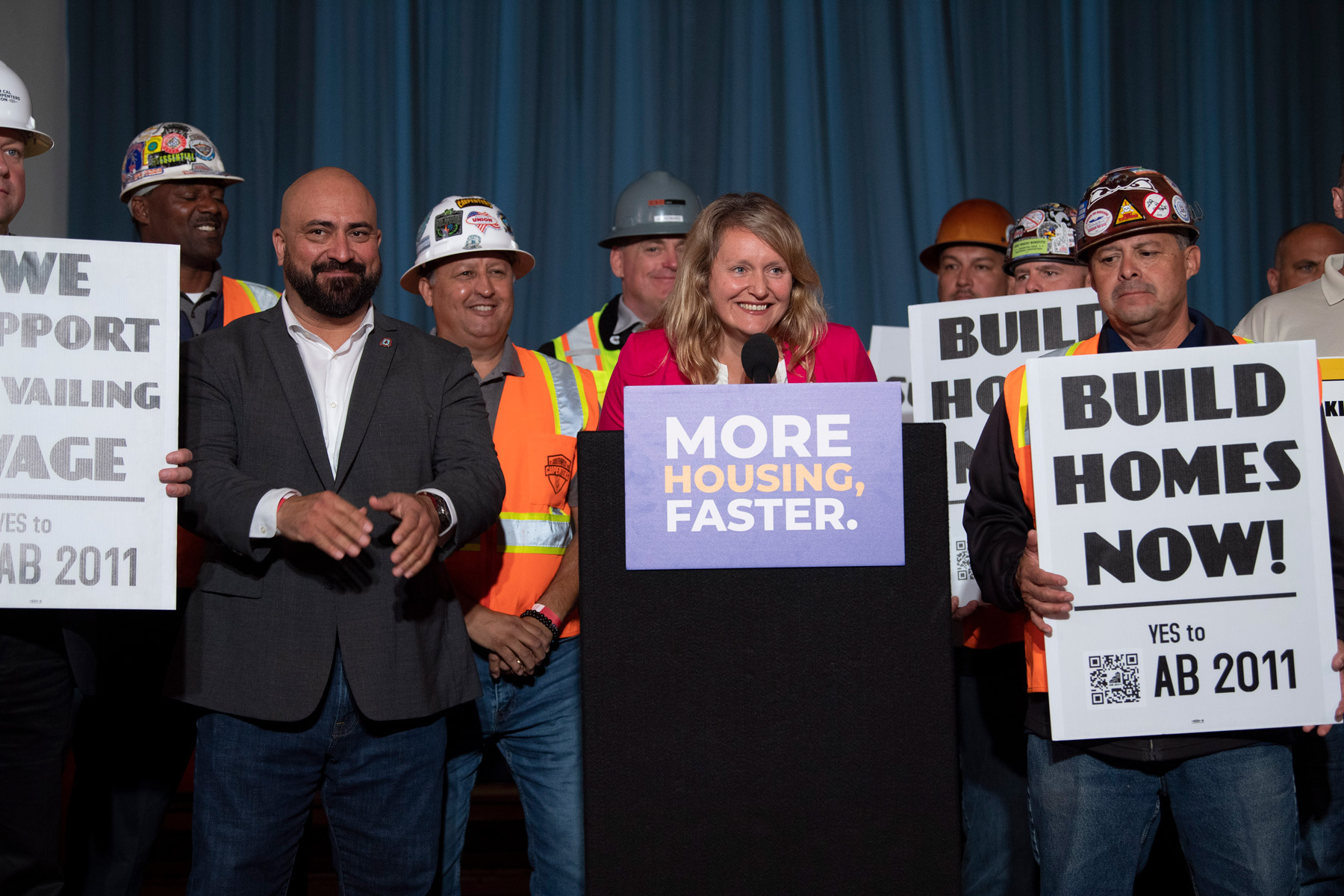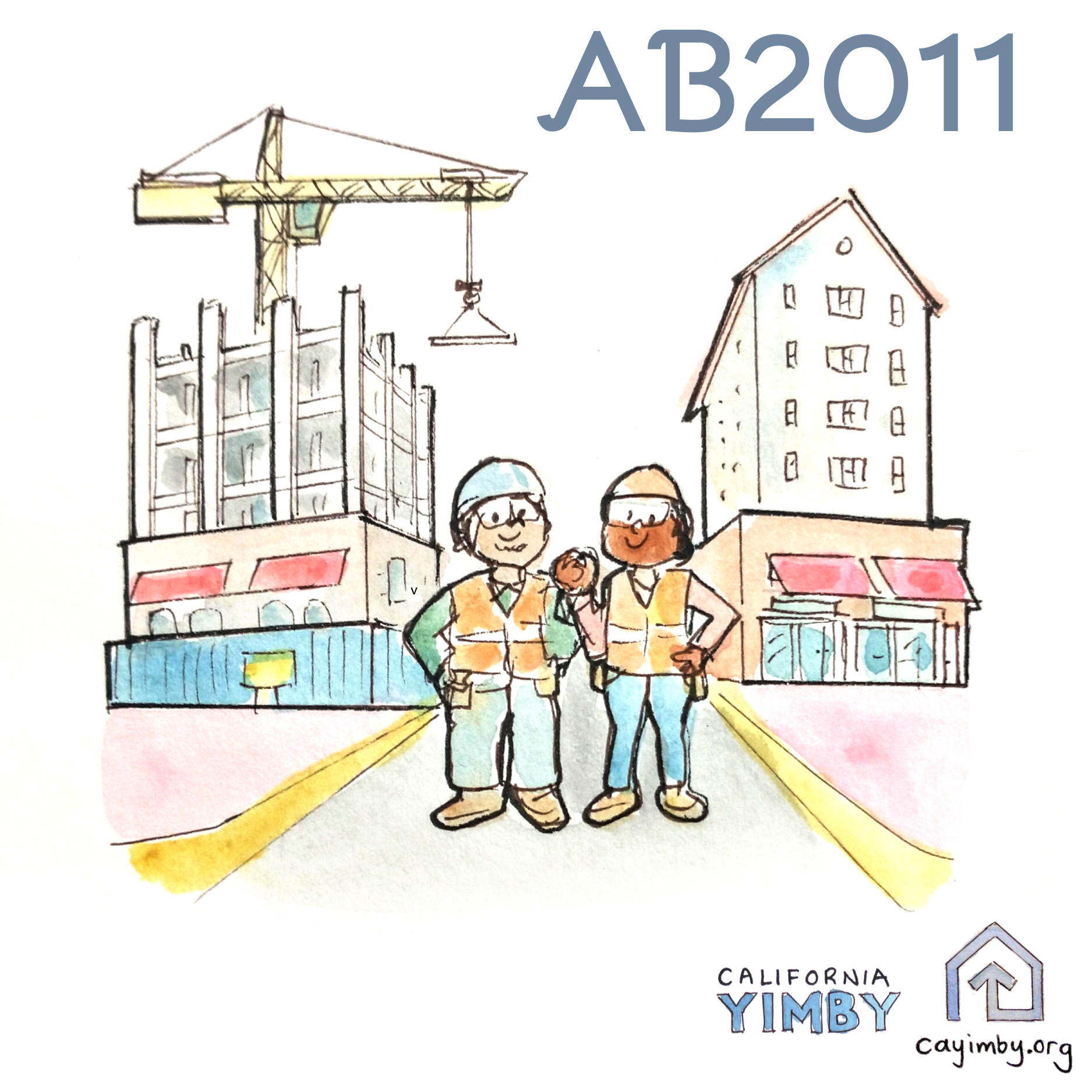
AB 2011 Explained
AB 2011 (Wicks) – The Affordable Housing and High Roads Job Act of 2022
Photo: Office of Assemblymember Buffy Wicks https://a14.asmdc.org/photo
What is AB 2011?
AB 2011, also known as the Affordable Housing and High Road Jobs Act of 2022, provides a streamlined approval process for housing development projects that are located in commercial corridors. More simply put, AB 2011 makes it legal to build apartment buildings in commercially zoned areas, as long as they satisfy certain affordability conditions and the developer pays construction workers prevailing wages.
Broadly speaking, there are two types of projects eligible for AB 2011 streamlining. In both cases, the project must be a multi-family housing development.
Type 2 projects are subject to stricter rules than Type 1 projects, as outlined in greater detail below.
Type 1:
a multi-family housing project where 100% of the units (except managers’ units) are affordable. The housing may be intended for sale or rental.
Type 2:
a multi-family housing project that devotes a certain portion of its units to low income households.
- In the case of a project where the units will be owned by their residents, then either 15% of the units must be affordable to low income households OR 30% of the units must be affordable to moderate income households.
- In the case of a project where the units will be rented by their residents, then either 15% of the units must be affordable to low income households OR the project must allot 8% of its units as affordable to very low income households and 5% to extremely low income households.
- In the case of a project where the units will be rented in a jurisdiction with a local inclusionary zoning mandate, then the project must satisfy the stricter of the inclusionary zoning mandate and the affordability requirements outlined in the previous bullet point. In some circumstances, the developer may reduce the number of affordable units below what the inclusionary zoning rules require.
Where can an AB 2011 project be built?
AB 2011 projects can only be built on sites that meet the following criteria:
- The site must be in a commercial zone – that is, office, retail, or parking must be a principally permitted use on the site.
- The site must be located in an urban area. If the site is in an incorporated city or town, it will almost always qualify for AB 2011. If the site is not in an incorporated city or town, it must be entirely within an “urbanized area or urban cluster” as defined by the U.S. Census Bureau. You can find maps of these areas here (note they are based on the 2010 census and may be slightly out of date).
- Most of the adjoining parcels (including parcels across a street or highway) must have previously hosted or must currently host residential, commercial, public institutional, transportation facility, or retail uses. Specifically, at least 75 percent of the AB 2011 site’s perimeter must adjoin (directly or across a street or highway) parcels with such uses.
- If the site is in a Neighborhood Plan Area, the Neighborhood Plan must allow for multi-family housing.
AB 2011 projects cannot be built on the following types of lots:
-
Lots with more than one-third of their area dedicated to or zoned for industrial uses, and lots adjacent to any lot (including lots across a street or highway) with more than one-third of its area dedicated to or zoned for industrial uses.
-
Lots that are vacant and contain tribal cultural resources that could be affected by development.
-
Lots within 500 feet of a freeway.
-
Lots within 3,200 feet of an oil or natural gas extraction or refinement facility.
-
Lots in any of the following categories:
-
Prime farmland or an area designated for agricultural preservation
-
Wetlands
-
A high fire hazard zone (unless the site is non-vacant and has adopted mitigation measures)
-
A hazardous waste site
-
An earthquake fault zone
-
An area prone to flooding
-
A habitat conservation area or habitat for endangered plant or wildlife species
-
Land under a conservation easement
-
Lots in a historic district or hosting a historic landmark
-
A mobile home or RV park
-
On top of all this, in very limited circumstances, the local government can exempt lots from AB 2011. They must do this before a developer has submitted an AB 2011 application, however.
Additional Requirements for Type-2 AB-2011 Projects
Type 2 projects must satisfy the following additional requirements:
- The lot must have at least 50 feet of frontage on a high-volume street or highway (but not a freeway) that is between 70 and 150 feet wide.
- The lot must be no larger than 20 acres.
- The lot may not be both vacant and zoned for housing, but not multi-family residential use.
- The site cannot have hosted residential tenants within the last ten years, whether or not the building that hosted those tenants has been demolished.
- The site cannot currently contain one to four residential units.
In addition, Type 2 projects cannot:
- Require demolition of affordable housing or rent-controlled housing.
- Require demolition of a structure on a local, state, or national historic register.
How big can an AB 2011 project be?
The legislature intended AB 2011 to produce dense infill housing. AB 2011 projects must therefore exceed certain density targets. Type 2 projects must also stay within height limits: since they are not 100% affordable, the legislature did not want to give them a blank check to build to any size.
Type 1
AB 2011 projects must meet or exceed a specific density level. That density level is:
- In incorporated cities in non-metropolitan counties, 15 units per acre;
- In suburban jurisdictions, 20 units per acre; and
- In jurisdictions in metropolitan counties, 30 units per acre.
Maximum unit allocations do not apply to Type 1 AB 2011 projects. All that matters, with regard to the number of units, is that the project satisfies the density rules described above.
(For further details on the required densities and which jurisdictions count as “metropolitan,” you can refer to this memorandum from HCD.)
Type 2
AB 2011 projects must meet or exceed the following densities:
- In metropolitan jurisdiction, the least restrictive of:
- The density allowed by local land use rules;
- 30 units per acre for lots less than one acre;
- 40 units per acre for lots of one acre or larger on a street less than 100 feet wide;
- 60 units per acre for lots of one acre or larger on a street at least 100 feet wide; and
- 80 units per acre for lots within half a mile of a rail or bus rapid transit stop, a ferry terminal served by a bus route, or the intersection of two bus lines that come at least every 15 minutes during rush hour.
- In a non-metropolitan jurisdiction, the least restrictive of:
- The density allowed by local land use rules;
- 20 units per acre for lots less than one acre;
- 30 units per acre for lots of one acre or larger on a street less than 100 feet wide;
- 50 units per acre for lots of one acre or larger on a street at least 100 feet wide; and
- 80 units per acre for lots within half a mile of a rail or bus rapid transit stop, a ferry terminal served by a bus route, or the intersection of two bus lines that come at least every 15 minutes during rush hour.
(For further details on the required densities and which jurisdictions count as “metropolitan,” you can refer to this memorandum from HCD.)
Type 2 AB 2011 projects’ density is capped by a height limit, which is the greatest of:
- The local rules governing height limits;
- On a street less than 100 feet wide: 35 feet;
- On a street at least 100 feet wide: 45 feet;
- On a parcel that is (a) in a city with a population greater than 100,000, (b) not in the coastal zone, and (c) within half a mile of a major transit stop: 65 feet.
Note that this explainer is intended as a rough sketch of the density rules, and the full text of AB 2011 includes complexities that may change these rules in certain circumstances. But this explainer is designed to cover the great majority of cases.
What zoning standards apply?
Objective Planning Standards
An AB 2011 project must also comply with objective planning standards. A project is compliant with objective planning standards so long as there is substantial evidence that a reasonable person could conclude it is compliant. This is meant to be a relatively low bar to clear: cities cannot insist on stringent interpretations of their planning rules.
Interaction with the Density Bonus Law
AB 2011 projects are eligible for a density bonus, concessions, or waivers pursuant to the density bonus law. Thus, AB 2011 projects may exceed the caps on height and density outlined above, provided the density bonus law allows it.
Parking Requirements
No parking requirements may be imposed on a Type 2 AB 2011 project, except:
- Bicycle parking requirements;
- Handicapped car parking requirements; and
- Requirements for parking spaces with electric vehicle charging capabilities.
Type 1 AB 2011 projects do not receive this protection, but they are eligible to receive waivers or reductions of parking requirements under the density bonus law.
Setback Requirements for Type 2 AB 2011 Projects
Type 2 AB 2011 projects face certain maximum setback limits. For the portion fronting on a commercial corridor, a building’s front must be located within ten feet of the property line for at least 80 percent of the frontage – but any parking must be set back at least 25 feet. For the portion fronting on a side street, a building must be located within ten feet of the property line for at least 60 percent of the frontage.
No setbacks may be required for portions of the parcel abutting adjoining properties on the same commercial corridor as the AB 2011 site, unless the adjoining property contains a residential use built before September 28, 2022. In that case, as well as for other adjoining parcels with a residential use, the ground floor of the AB 2011 project must be set back ten feet. Higher floors must be stepped back seven feet for each floor. For other adjoining properties with non-residential uses, the AB 2011 project must be set back 15 feet.
These setback requirements may be reduced by the local government.
Additional Rules
In addition to these standards, many local rules concerning housing and land use (for example, building codes and inclusionary housing requirements) will apply to AB 2011 projects. However, a local government cannot impose rules or fees on AB 2011 projects solely because they are AB 2011 projects. Furthermore, only objective design standards apply to the project.
What if there are existing tenants?
Restrictions on AB 2011 Projects to Protect Low-Income Tenants
To avoid situations where an AB 2011 project would hurt low-income tenants or demolish housing, the legislature has imposed various restrictions:
- An AB 2011 project cannot demolish more housing units than will be created.
- An AB 2011 project must replace any and all affordable or rent-controlled units that will be demolished.
An AB 2011 developer must provide relocation expenses to low-income tenants who will be forced to move, and the developer must give these tenants a right to return: that is, they must offer low-income tenants a unit in the AB 2011 project at an affordable rent when the project is completed.
Notice and Relocation Assistance to Commercial Tenants for Type 2 Projects
Applicants for type 2 projects must provide written notice to all commercial tenants on the site when the application is submitted. They must also provide relocation assistance to local businesses that have rented space on the site for at least one year. The amount of assistance required increases with the length of time the business has operated on the site: one to five years, six months’ rent; five to ten years, nine months’; ten to fifteen years, twelve months’; fifteen to twenty years, fifteen months’; and twenty years and over, eighteen months’. The business must spend the assistance on relocating or starting a new business.
What happens after you get your application together?
Streamlined review process
If an AB 2011 project meets the requirements described above, the jurisdiction must approve the project ministerially – that is, the jurisdiction has no discretion to deny the project. If the jurisdiction believes the project does not meet these requirements, it must reject the application within 60 days (if the project has 150 units or fewer) or 90 days (if the project has over 150 units). The jurisdiction may not reject an AB 2011 application solely because it is missing materials, so long as the materials that were submitted provide substantial evidence that would allow a reasonable person to conclude the project meets the requirements. If the jurisdiction misses the 60 or 90 day deadline, the project is deemed to be compliant with the relevant zoning rules and other land use standards.
Finally, if a public improvement is required as part of the project, the local government cannot withhold approval for public improvement as a means to deny the project.
Labor Standards for AB 2011 Projects
AB 2011 developers must pay their workers prevailing wage. This includes workers hired by subcontractors.
Projects with 50 units or more must meet additional requirements. Construction contractors and subcontractors must either participate in a state-approved apprenticeship program or request the dispatch of apprentices from such a program. Construction contractors and subcontractors must also make health care expenditures at the pro rata hourly cost of a platinum level Covered California plan for two adults and two dependents 0-14 years old. (These expenditures count towards prevailing wage requirements.)

